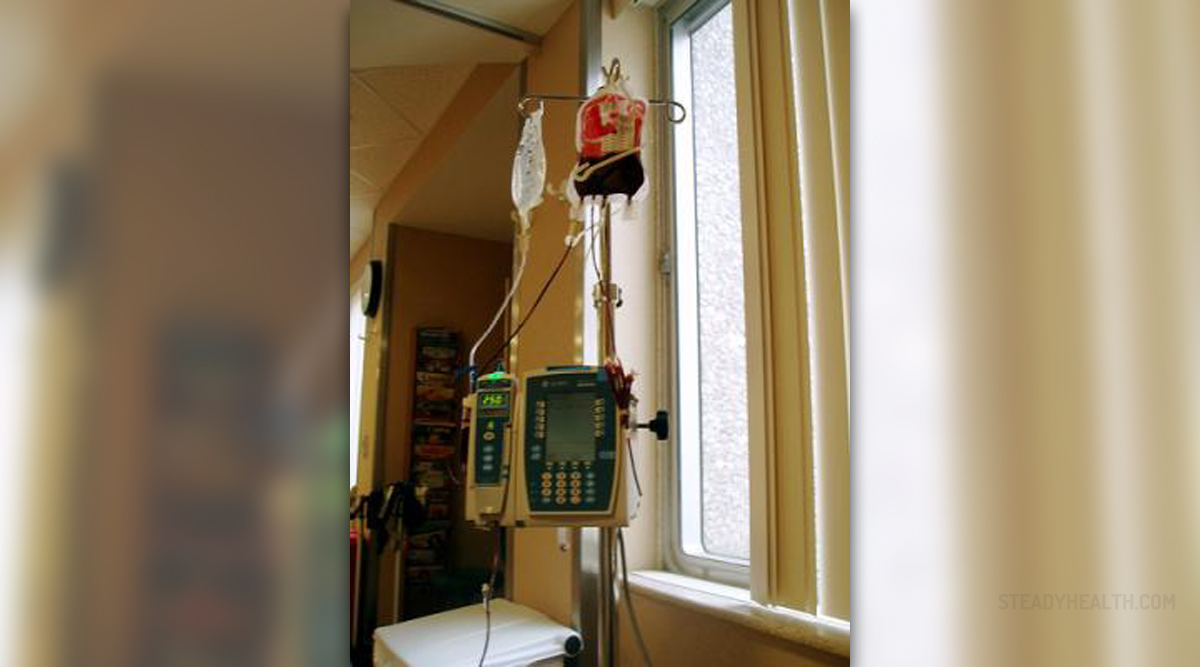Blood transfusion is a process of transferring the blood from one person to another. The most common reasons for blood transfusions are loss of blood because of the surgical procedure or injury and various blood diseases, such as anemia, thrombocytopenia or hemophilia. In the old days, doctors used whole blood for transfusion, while modern medicine uses only blood components necessary for the specific patient. This way, just one blood donation may improve or save several lives.
When Blood Transfusion Goes Wrong
Blood transfusion side effects are known to occur in some cases. Patients may experience fever, allergic reaction, hemolytic reaction and different infections. Some side effects are visible right away but others will appear weeks or months later.Fever is the most common side effect in people receiving blood transfusions. It might be associated with nausea, chills, headache or breathing problems. This symptom is not a severe one and it usually takes just acetaminophen tablet to solve the problem.
Allergic reactions are somewhat rarer than the fever in blood transfusion patients. Allergy is caused by the presence of some substances in the given blood and might cause itchiness, redness, swelling and urticaria. Doctors will most likely prescribe some antihistamines if a person suffers from an allergic reaction to the transfusion.
All immunization is the reaction of the recipients’ body to the donated blood or specific components of blood. Because of this process donated blood is not working the way it should. It can be avoided by filtering the white blood cells out of the blood for transfusion.Infections are also very rare nowadays, due to the fact that the donated blood is always checked for bacteria, viruses and parasites. However, sometimes patients can develop bacterial infections due to the skin bacteria of the donor.
Hepatitis B and C can also be transmitted through the blood. The risks of suffering from the hepatitis because of the blood donation are very low because blood banks always make sure to know the medical history of the donors, before giving blood. To be sure, blood banks also test every donated unit of blood for hepatitis B and C. HIV causes AIDS and can be transmitted through the blood transfusion. As with hepatitis, blood banks question every donor about their health condition and additionally test every donated blood for HIV.
- Of 38,013 units of blood and components that had been issued, 101 (0.2%) cases had an ATR.
- The most common reaction was allergic - 34/101 (33.6%) followed by febrile - 26/101 (25.7%).
- Other reactions included transfusion-related acute lung injury in 6/101 (5.9%) cases, and immune reactions were seen in 19/101 (18.8%) cases.
Transfusion-related acute lung injury is not that common but it is a severe side effect of blood transfusion. TRALI can cause extremely high fever or breathing difficulties and is treated with oxygen and breathing machine if necessary. Hemolytic reaction is even rarer than TRALI and this happens when the donated blood is not the right match for the transfusion. It can be acute or delayed, depending on the symptoms appearance and in some cases it can be life threatening.
Graft versus host disease is a reaction of white blood cells from the donated blood against the recipient tissue. GVHD is much more likely to affect and cause complications in patients with immune system disorders, or patients that receive the blood from their relatives. Therefore, every donated blood is treated with low radiation which is known to prevent GVHD.
Blood Infection may Come After Transfusion
One of the most common infections of the blood is septicemia, but there are many others. Blood infection is also one of the most common blood transfusion side effects. The problem of blood infections is connected with the infection of the blood plasma and blood cells, which happens due to the pathogens influence. The most common type of blood inflammation is septicemia or sepsis. This problem can mistakenly be confused with blood disorders. These blood disorders are non-contagious and genetic by nature.
People should know that septicemia and sepsis are not the same thing and there is a difference between them. When sepsis is considered, the toxins are found in the entire body, when this problem is present. The toxins will spread through the body. On the other side, septicemia involves bacteria located in the bloodstream and this problem is known as bacteremia. These two types of blood infection are the most serious ones and they seek medical attention.
There are many different causes of blood infection, but the most common is the bacterial infection. This problem can be created even due to the viruses and fungi, if the individual is having a low strength immune system. The problem can move from the central point of the infection, or the infected nidus, to other locations in the body. The infected nidus can be a simple cut or even a major organ from where the infection will spread. The problem of the blood urinary infection begins from the lungs, from where the septicemia arises. Blood infection can also be created by the spreading of the infection, cellulitis infection, ruptured appendicitis or appendix, or meningitis. The spreading of the infection will be faster if the infection is originating from the abdominal organs. Surgery can also lead to blood infection, but these cases are not that common.The most common symptoms include fever, faster breathing, tachycardia, confusion, disorientation, severe headaches and rash on the skin.
Treatment and Risk
In order to treat the problem, a proper cause must be identified. When this is done, the treatment may start. Treatment must be given by a professional, especially if the patient is having another treatment for some other condition. Antibiotics are the most common methods of treatment. They can be administered intravenously, which is rare, or orally.People who have weak immune system, debilitating disease like AIDS, diabetes or cancer, who had organ transplantation, have spleen problems, take immunosuppressive drugs, experienced severe burns, who take steroid for a longer period of time and those who undergo radiation therapy or chemotherapy are at higher risk of developing some kind of a blood infection. In order to get the best treatment, people should visit a professional when problem is detected.


















Your thoughts on this
Loading...